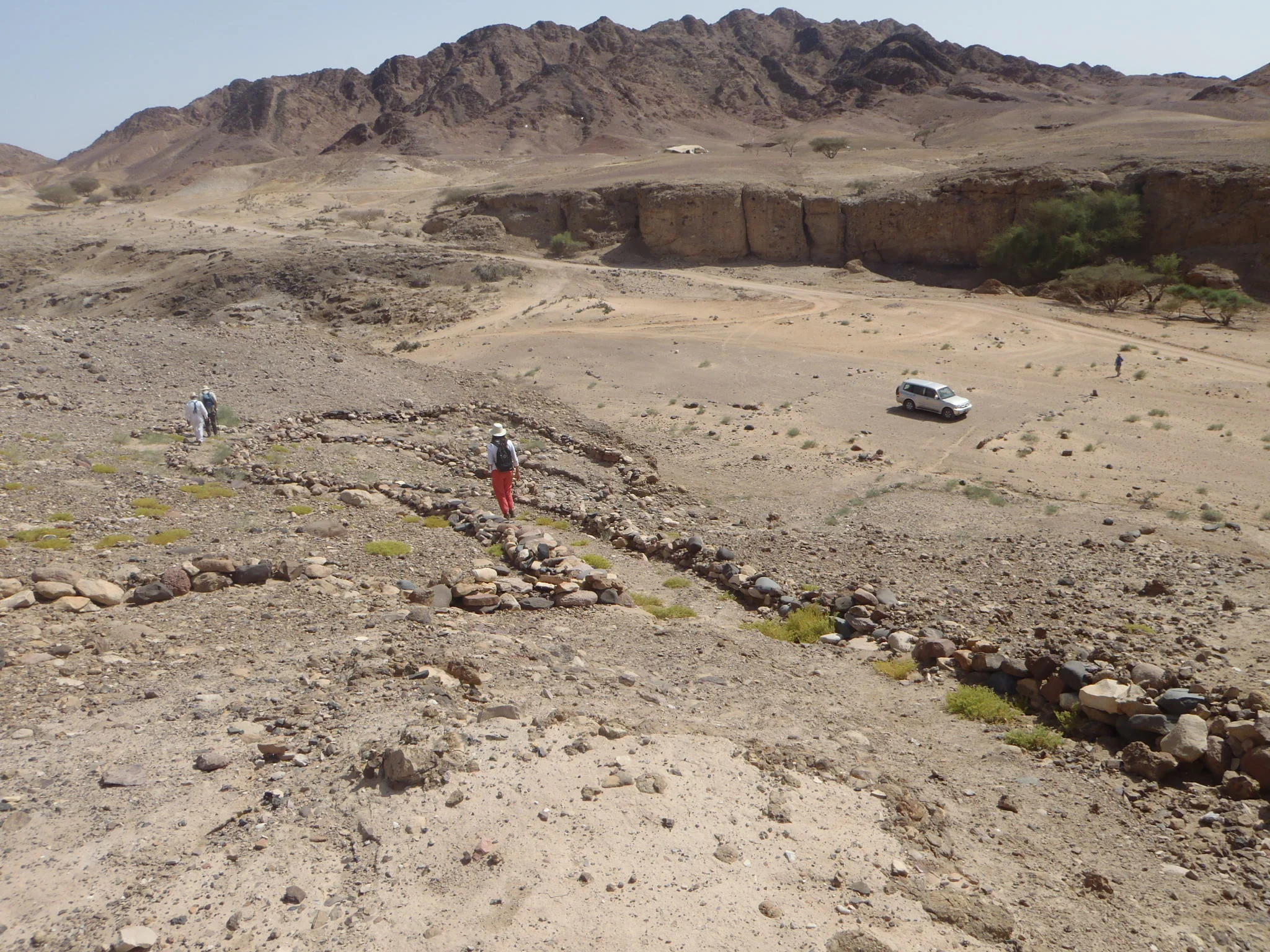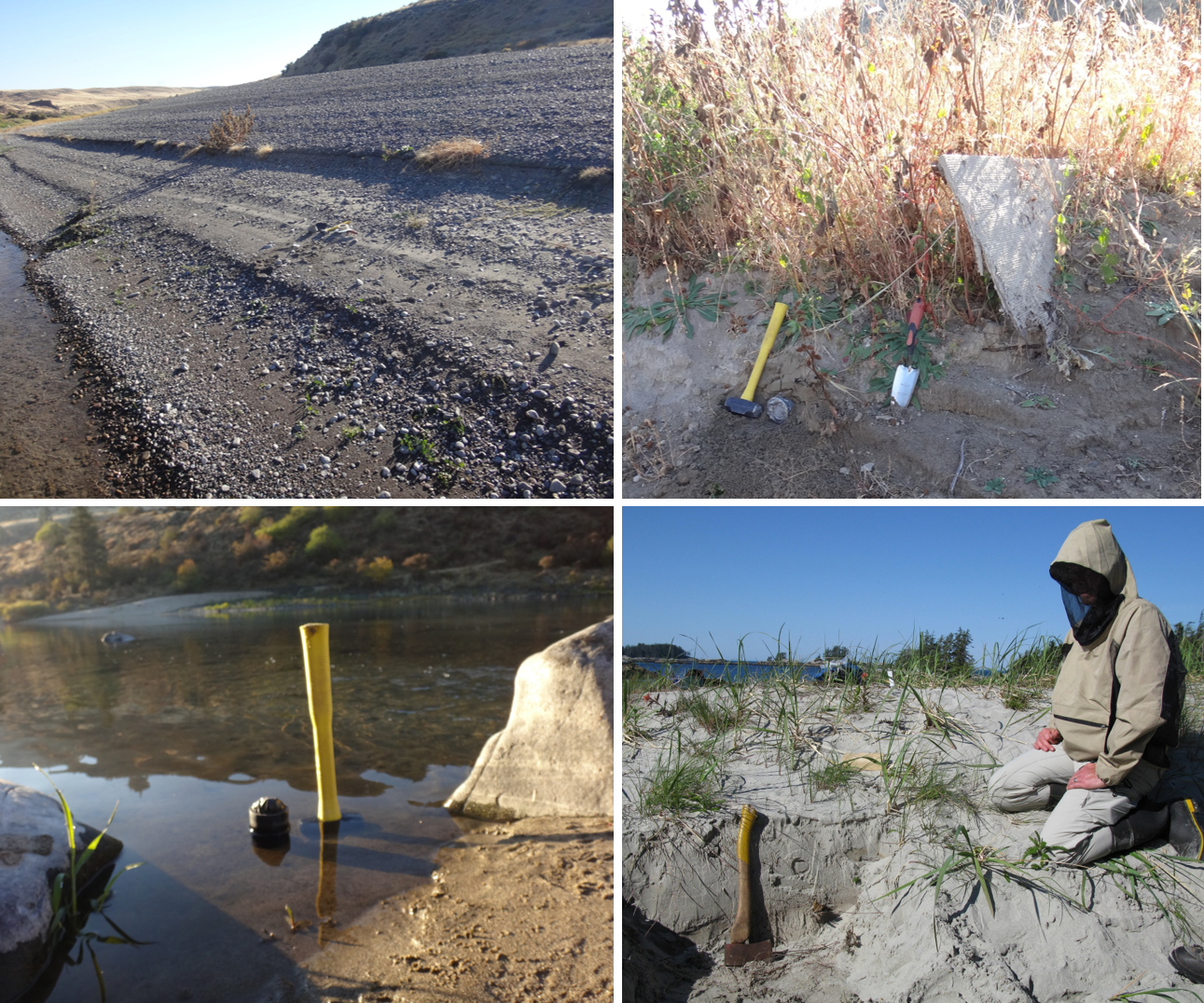Sampling for luminescence dating - Part I
/Samples for luminescence dating can be collected in a myriad of ways, and can include different types of material. Materials most commonly dated are grains of sand or silt, however pottery, rock surfaces, rock art, and even archaeological constructions, such as walls and buildings have also been sampled.
Because luminescence dating methods determine the last time a mineral has been exposed to light or heat, it is imperative that light or heat is not introduced to the sample during the sampling process. This can be tricky! Below we list some common, and not so common ways of collecting luminescence samples. Stay tuned for upcoming blogs that delve into more details about the sampling process.
1) Sampling tubes. This is the most common method of collecting a luminescence sample from sediments. Sampling tubes are typically hammered into a sedimentary exposure, or the side of an archaeological trench, to collect sediments from the sedimentary unit or archaeological layer of interest.
Before hammering, the tube may be stuffed with foam, plastic or paper. After the tube is fully inserted, it is then excavated back out, and the light-exposed ends are sealed with opaque plastic, tape or a cap. The size of the tube you use, will depend on the thickness of the unit/layer you are sampling, and how much time you think it took for the sediment to accumulate. To avoid obtaining an imprecise age, tubes of smaller diameter should be used for sedimentary units thought to have accumulated over long periods of time.
Luminescence sample tubes of various sizes (LEFT). A steel cap may be placed on the end of the tube to protect it during hammering (RIGHT), and the tube ends can be sealed with a cap, opaque plastic or tape. Sample tubes are commonly stuffed with a paper, plastic or foam “plug” (RIGHT) prior to hammering the tube into the sediments. This ensures that the sediments remain compact, minimizing any mixing between sun-exposed grains and non-exposed grains during transport. If a sample is collected subaqueously, it is not advisable to use a plug, as this may force sediment-laden water back out the unplugged end, contaminating non-light-exposed sediments.
2) A hand auger. Luminescence samples can be collected using an auger equipped with a light-tight core sampler, allowing us to target sediments several meters below the surface.
Luminescence sampling by hand auger (LEFT). A beveled, light-tight core sampler (RIGHT). Photo credits: Amanda Keen-Zebert (left), christina neudorf (right)
3) Coring. Luminescence samples can be extracted from sediment cores that have been collected by hand, by percussion coring, or by vibracoring. If cores are collected from loose or saturated sediments, a core catcher maybe placed at the penetrating end of the core to prevent sediment from falling back out during extraction.
Sediment cores collected by hand using ABS pipe (LEFT). ABS pipe is less prone to fracture than PVC pipe, especially in rocky substrates. Cores may be extracted using a tripod and winch system (LEFT-CENTER). A core catcher (RIGHT-CENTER & RIGHT) can prevent the loss of sediment during core extraction. pHOTO CREDITS: CHRISTINA NEUDORF
In a light-safe lab, multiple luminescence samples can be extracted from a single core to construct “age vs depth” profiles.
Core sample sediments in a light-safe lab, ready for subsampling for luminescence dating AT THE UNIVERSITY OF THE FRASER VALLEY. PHOTO CREDIT: CHRISTINA NEUDORF
4) Block samples. When luminescence sample tubes cannot penetrate extremely cohesive sands or silts, it may be necessary to extract a block sample. This can be done using a rock hammer or saw. After sampling, the block is wrapped tightly in opaque plastic, then shipped in containers with sufficient cushioning (e.g., bubble wrap) to prevent the block from cracking during transport. Once in the light-safe lab, the outer-most sediments are carefully carved away from the block before the inner, non-light-exposed sediments are processed for dating.
A block sample collected from cohesive sandy silts along the Snake River, Idaho. PHOTO CREDITS: TOM BULLARD
5) Under a tarp, or at night. If light contamination cannot be prevented using sampling tubes or cores, a sample may be collected under an opaque tarp and/or at night. Finding tarp material that is truly light-safe can be tricky, and multiple layers may be necessary. As always, the sample must be packaged in such a way that any surface sediments that were exposed to the sun during the day do not contaminate the non-light-exposed sediments.
Luminescence sampling under a tarp IN NEWFOUNDLAND, CANADA. Tape was applied to creases susceptible to light penetration, and multiple layers of material was used. If you choose to sample this way, do it quickly and with lots of helping hands - You do not want to suffocate! PHOTO CREDIT: GREGORY MUMFORD
6) Rock surface sampling. The surfaces of boulders or cobbles can be sampled for luminescence dating by coring and slicing (e.g., Freiesleben, et al., 2015; Jenkins et al., 2018). Rock surface dating has also been applied to rock art (e.g., Liritzis et al., 2018). Cores can be extracted using a hand drill with a diamond-tipped drill core, then sliced into sub-centimeter thick slices using a microsaw or wafering blade. A water cooling system for both the core and saw may be necessary to prevent the sample from heating up due to friction. Rock slices may be crushed and prepared as sediment samples prior to measurement, or measured directly.
Rock surface sampling steps for luminescence dating. the ~9 mm diameter rock core was extracted from a granite boulder from Quadra Island, British Columbia, Canada. The rock slice is from granite sampled by Meyer et al. (2018). Slices can then be mounted into a luminescence reader and measured directly as shown by Freiesleben (2014) (FAR RIGHT).
7) Brick or stone structures and monuments. Pieces of archaeological structures can be sampled by chiselling, coring, or, in the case of limestone structures, acid treatment prior to the extraction of quartz inclusions (e.g., Bailiff, 2007; Liritzis, 2010; Stella et al., 2014).
Drill core sampling brick from a late-Post medieval English building (Bailiff, 2007) (TOP). Method of sampling a megalithic wall (shown is Mykerinus pyramid, Egypt) (BOTTOM) (Liritzis, 2011).
In most cases, it is desirable to collect a “modern” sample to check how well the luminescence signal is re-set during sun-exposure. This allows us to evaluate ages from our ancient samples, by determining the likelihood that their signals were also fully re-set prior to burial. The modern sample should be collected from rocks or sediments that have experienced the same mode of transport and deposition as the ancient samples. Unfortunately, even when this is the case, there is always the possibility that the bleaching history of the modern sample will not be representative of the ancient samples collected at the same site.
Modern samples should be collected at sites with bleaching conditions thought to be representative of the ancient samples of interest. (TOP LEFT) A modern sandy gravel bar in the Snake River, Idaho. (TOP RIGHT). A vegetated sand bar in the Snake River, Idaho. (BOTTOM LEFT) Shallow-water river sediments adjacent to an archaeological site in Idaho. PHOTO CREDITS: CHRISTINA NEUDORF. (BOTTOM RIGHT) The crest of a sand dune on Calvert Island, British Columbia. PHOTO CREDIT: OLAV LIAN










